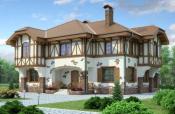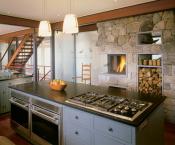Search
Login
How to protect painted surfaces?
Currently, there is a huge selection of chemistry for any purpose. In this article we will try to highlight the use of chemicals to strengthen the problematic foundation in preparation for the finish coating.
Content
- Primer - reinforcer of problematic bases
- Primer for protection and painting of metal video
- Subtleties in the color of facades
- Enamels - smooth colored films
- Chemistry in the protection and coloring of wood
- Special paints for structural plaster
- Getting Started Tips
- Safety precautions
Primer - reinforcer of problematic bases
Good primerable to prevent shedding of the old base or chalking.
After priming, the consumption of the finish coating is significantly reduced, the adhesion of the finish to the base is significantly improved.
Well-absorbing materials, such as drywall, must be primed, otherwise, in the absence of a primer, the normal course of hardening of paints will be disturbed.
Thus, the service life of the topcoat is significantly reduced.
Uncoated, water-absorbing substrate absorbs water instantly applied plaster or paint and the final result is reduced to zero.
There is an insulating primer - it is applied in the case when there are traces of leaks or various indelible spots on the surface prepared for painting.
If the insulating primer is not applied, these spots can appear through the paint and spoil the appearance.
It is necessary to apply a protective primer to any cement screed before painting with oil paint, otherwise the alkali released from the cement screed will deform and soften the paint layer.
A primer with water-repellent properties is applied to the main walls, such a primer is able to protect against penetration of moisture deep into the base, but at the same time does not interfere with the respiration of the walls.
There are primers for special purposes - they are used to simplify the work with decorative plasters.
Primer and decorative plaster are made by the same company.
Important! A primer is applied to each layer of the treated surface, i.e. before plaster, after plaster before putty, before finishing painting or wallpapering.
Primer for protection and painting of metal
Metal usually has a smooth surface, but is more prone to corrosion.
Those. the primer for metal is to destroy the rust and help the finish coat catch on the metal.
If ordinary paint is applied to rusty metal, the metal will also break down under the paint, as the corrosion process will continue.
Currently, there are decorative paints, which include inhibitors that can destroy rust and slow down corrosion.
In everyday life, painting of metal roofs is often required, for this there are special tools - most often they are also suitable for painting slate.
Many high-quality paints for metal can withstand heat up to 80 * C and therefore are suitable for painting radiators, i.e. batteries.
Subtleties in the color of facades
Modern facade paints must possess not only high-quality decorative properties, but also good elasticity, frost resistance, strength.
To fulfill all these conditions, paints based on acrylic dispersions and silicone resins are produced.
Silicate paints based on liquid potash glass have the highest breathability.
Before choosing a facade paint, it is necessary to analyze the quality of the substrate, its absorbency, and biological activity.
It is necessary to pay attention to climatic conditions and the degree of air pollution, it is necessary to take into account the vapor and gas permeability of the coating.
In addition, take into account the quality of the waterproofing of the foundation.
When painting a reinforced concrete base, it is necessary to protect the reinforcement from the action of carbon dioxide, i.e. gas permeability of the coating should be minimal.
A prerequisite for painting the facade is the absence of precipitation, strong wind, direct sunlight, the temperature should be above + 5 * C.
Enamels - smooth colored films
Enamels are produced on the basis of organic solvents.
Enamel is able to create a solid and durable film.
Almost everything can be painted with enamel: metal products, wooden, brick, concrete.
But enamel has one drawback, since it is a low elastic film and if the base changes dimensions, i.e. deformed - the film may tear i.e. crack.
Acrylic enamels dry very quickly, practically odorless, non-toxic.
Such enamels are used for furniture coloring, window and doorways, wooden floors, for painting roofs.
Alkyd enamels are aggressive, when working with them it is necessary to apply protective measures and organize good ventilation.
Alkyd enamel is resistant to abrasion, withstands heating up to + 90 * C, withstands chemical attack.
This enamel is good for painting walls, ceilings and floors.
Chemistry in the protection and coloring of wood
Danger lurks wood at every step.
This is especially true of wooden products located in the fresh air.
Depending on the conditions for finding wooden objects, protective equipment is also chosen.
Fire retardants protect wood from the fire.
Fungicides, algaecides, insecticides, and all these are biocides - protect wood from fungi, algae and insects.
These chemicals treat the tree and give prevention.
Such chemistry can suspend the lesion, can prevent the appearance of such lesions in the future.
Bleaches can restore the appearance of damaged wood.
New generation chemicals contain organic substances, they are less harmful to health, often have decorative properties.
Translucent materials are also called glazing.
In addition to these chemicals, classic products are used as wood coloring, they are able to form an opaque film and also protect the wood from an external aggressive environment.
Special paints for structural plaster
High-quality modern paints create a spectacular texture and imitate the surface of a wide variety of materials.
Applying these paints in the most multidirectional movements with a brush or spatula, in this way they form various relief patterns.
Such paints may contain decorative inclusions: spangles, mineral chips, natural fibers, etc.
The advantages of such paints, in addition to their beauty, include the ability to hide small irregularities in the base.
Experts advise to process such a textured plaster with a special colorless wax, thereby creating additional protection for the finish, enhancing its expressiveness.
Getting Started Tips
Before applying paints and varnishes, the base must be cleaned and dried.
It is necessary to remove all old crumbling coatings, then wash the surface with warm water and soap and wipe dry.
Wooden bases are treated with antiseptics, pre-clean the foci of biocorrosion.
Prior to painting, metal surfaces must be degreased using alcohol, gasoline or acetone.
Safety precautions
Carefully read the instructions for working with household chemicals.
Use personal protective equipment.
Create high-quality ventilation of the room.
Work with a partner.
If any paint material gets into your eyes, flush eyes with plenty of water.
If necessary, consult a doctor, be sure to bring the label of this chemical with you.





